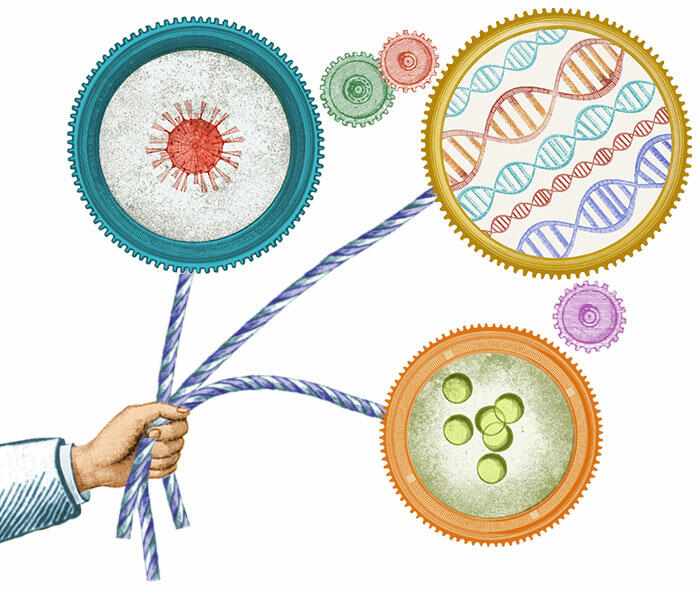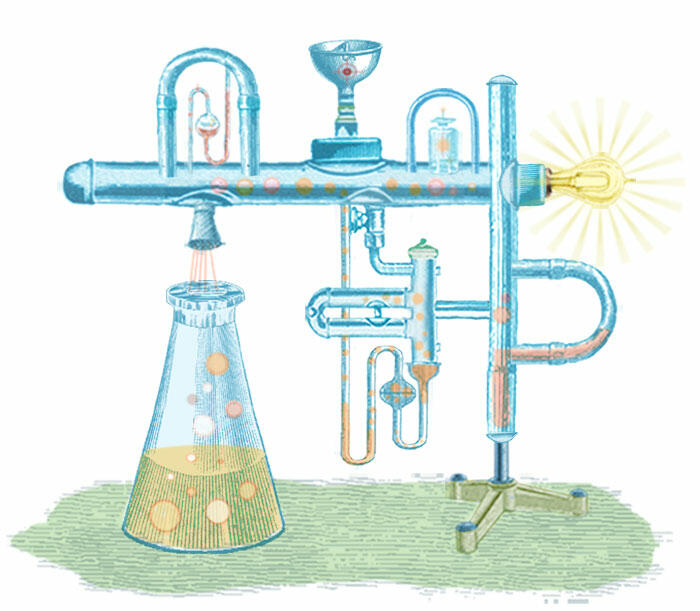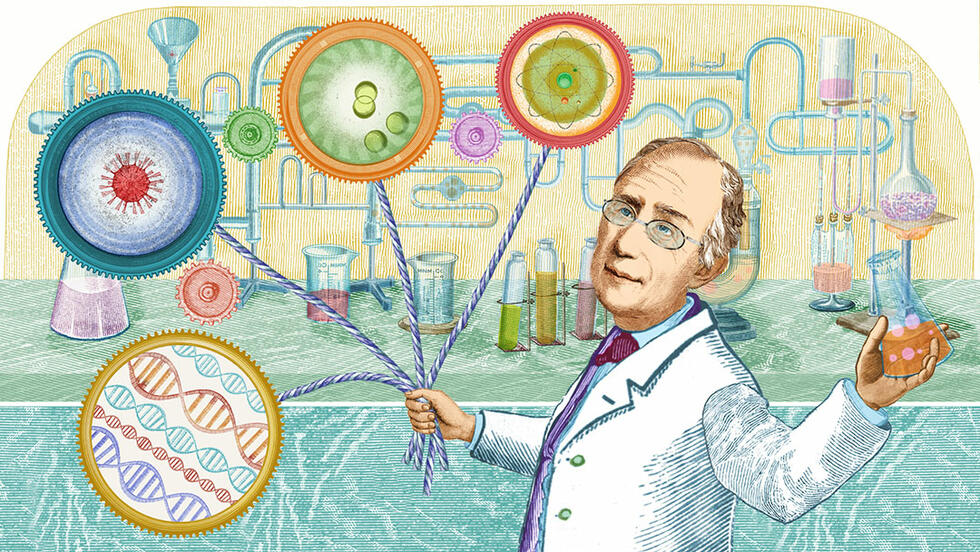Moderna co-founder Bob Langer in conversation
Robert Langer (73) has saved millions of lives with his research: His work with messenger RNA provides genetic blueprints with which the human body can produce antiviral proteins itself. This research forms the basis for the most successful Covid 19 vaccines, such as the vaccine produced by the manufacturer Moderna. Langer is a co-founder of the company and has become a billionaire since the Corona pandemic.

Jürgen Schönstein
It took only a few months from the beginning of the Covid-19 pandemic until the first vaccines became available – but your work that laid the foundation for these vaccines took quite a bit longer, didn’t it?
Robert Langer
Actually, it has been 47 years since I first started working on the delivery of macromolecules including nucleic acids – the vaccines are just one of the applications.
You spent almost five decades on this research – did you ever doubt that it would become such a big thing?
Well, you know, for the first 10 years of my career, I couldn’t get a research grant, I couldn’t get a faculty job in a chemical engineering department, and so that was very discouraging. But finally, we were able to publish a few good articles and we helped launch a few companies and products – not as big as the Covid vaccines, but systems to treat cancer and drug-eluting stents that built on the early research. These are in wide use now, and probably also saved millions of lives over the years.
“A few good articles and a few companies” is an understatement. You are one of the most widely published scientists in the world, and there are more than 1400 patents to your name.
It is a thrill to see that a company that I helped launch could make such a difference in the world!
I was thinking of the 1980s and 90s when I said that... but it certainly is a wonderful thing to think that the work we started – not just me, but also lots of other people – could make such a difference. It is a thrill to see that a company that I helped launch could make such a difference in the world. Using genetic information for therapeutic drug delivery is now a giant field, and that is good.
Moderna is one of your more recent startups…
Yes, we launched it in 2010.
What specific purpose did you have in mind when you launched the company? After all, we hadn’t even heard of Covid back then…
The objective was to develop messenger RNA therapeutics. Instead of introducing proteins into the human body that force the human immune system to find a way to build antibodies, like we do with the flu vaccine, we introduce the genetic blueprint to make the antibodies directly into the cells. That’s what Derrick Rossi, Ken Chien, Noubar Afeyan, and myself had in mind – any type of messenger RNA therapeutics. And these could include vaccines, cures for rare diseases, and various proteins. I really mean any type of RNA therapeutic.

But now the name Moderna is firmly associated with that particular Covid-19 vaccine, which might help broadcast the importance of messenger RNA as a drug delivery system – but could this also detract from other areas, like cancer research, that seemed far more pressing before the pandemic hit?
That’s fair, sure. But we are still driving forward clinical trials on cancer vaccine programs. In fact, this is precisely what the manufacturing plant was intended for, and I hope it still will happen. But you’re right: you solve one big problem because it’s the pressing thing at the time, and it might come at the expense of other research that, in the long term, is just as important.
Do you find this worrying?
Funding for medicine is a hard thing to come by, especially the kind of funding you need to create medical products and obtain FDA approval
Well, my hope is to do both. The positive thing is that the company now has the funding to drive other areas of research, and I think that’s really important: other vaccines, cancer vaccines. Funding for medicine is a hard thing to come by, especially the kind of funding you need to create medical products and obtain FDA approval. That is the silver lining, and in the long run it will help attract even more attention, more funding, and hopefully more people to work in this field.
Since you brought up money: Moderna shares have soared, making you a billionaire.
Yes.
How has this changed your life?
Well, it’s all just on paper. I have not sold a single share; I am a board member, and I believe in the company. Who knows what will happen to it in the long run – I mean, I hope its value continues to rise, and I can use it for something useful someday, in terms of charity and other issues like education and so forth.
Such as funding your own research? As a professor at MIT, you usually have to spend a lot of time just organizing funding for your research. So rather than spending weeks every year writing dozens of grant applications, you could fund yourself. Have you considered this possibility?
I think MIT might have some rules on that, but I do not plan to sell any shares while I’m on the board. It’s not going to happen, I’m not even thinking about anything along these lines right now.

Speaking of being on the board: you’re a serial entrepreneur who’s founded more than 30 companies…
Yeah, it’s probably close to 40 companies.
Over a 40+ year career, that’s almost one every year, on average…
I founded my first company in 1986, so since then, it’s actually been more than one a year.
You even have a startup partnership with Jennifer Aniston. How did that come about?
One of my former students, Amir Nashat, is a managing partner at Polaris, one of the venture groups that supported a lot of our spinouts. He had been talking to some people who wanted to start a hair care company, and they wanted me to help them to come up with some innovative ideas. We did actually come up with ideas about materials that could get rid of frizz and give hair more body. But Grace Ray, the CEO, said to me: “Bob, 95 percent of the people who use the product, like it, 95 percent reuse it – but less than 1 percent of potential customers even know we exist. We need to get somebody involved who the world would recognize.” So they talked to Jennifer Aniston and her agents, and she was very enthusiastic about the idea and decided to sign on. She actually visited me at my office several times. I still remember her asking me lots of questions about nanoparticles – she was great.
Most people struggle just to handle one startup at a time. What drives you to take on so many?
The way I look at these companies is almost like I think of children growing up: The first year or two, they need a lot of nurturing; a couple of years later they need less. And when they are grown up, they may or may not want anything to do with their father. My only goal for the companies – just as it is for my three children, two sons and a daughter – is to make sure they’re happy. I just want the companies to be happy and do good, and the people there to be happy.
Do your children resent that they have to share you with your companies?
My children are 27, 30, and 31, so they are grown up now, but I still spend a lot of time with my children and my wife. That’s the most important thing to me. Time with them and my students…
All those years of research, writing thousands of articles, even if they are co-written, filing patents – and still finding time for a private life and your children seems a daunting task…
I’m very lucky – my wife Laura supported me a great deal. When the kids were little, she told me, I want you home by seven every night to help put them to bed and tell them stories. And I love that, I loved spending time with my kids. I work very hard, but I actually don’t do much else: I either work, or spend time with my family. It’s not like I hang out with the guys and play poker or something like that.
I guess you’ve already been vaccinated against Covid-19?
Oh yes!

Just out of curiosity: What kind of shot did you get?
Moderna, of course!
Well, not everybody has a choice. Would you have concerns about other vaccines?
I don’t have anything against the other vaccines, but I think the data on the safety and efficacy of the Pfizer and Moderna vaccines have been truly remarkable.
These vaccines are more than 90 percent effective. By the same metric, these numbers are far above those of the annual flu vaccines. Is this due to the use of mRNA – or is it because we just put a more concerted effort into creating more efficient vaccines, given the current circumstances?
A good question – but one to which I don’t know if there’s a complete answer. First, there’s identifying how you’re going to stop the virus. For this, you’re going after the spike protein. Secondly, you’re using messenger RNA. Thirdly, you’re using nanoparticles as a delivery system, which may be a much more efficient delivery system in terms of getting into cells and lasting longer. I would point out those three things, whereas with the flu, they’re growing things in eggs to make proteins, and the targets change pretty substantially each year. So there are a lot of differences, but breaking down the individual contributions, that’s hard to do.
But will it be a game changer? Will all future vaccines have to be made like the Covid vaccines, rather than taking basically inactivated viruses and growing stuff in eggs?
When you hear “95 percent effective”, to me that isn’t even the most important number
I think that from what we’re seeing, messenger RNA has to be a way of the future. The data is excellent. When you hear “95 percent effective”, to me that isn’t even the most important number. It’s that, in the clinical trials, not a single person was hospitalized with Covid-19 after the vaccination – out of thirty thousand. You don’t need to be a genius to figure out just how important and special that was, after so many people had died.
And that it was accomplished so fast…
A lot of people seem to think that this happened out of the blue. But it was actually already the ninth vaccine Moderna entered into clinical trials. And the data from many of the other vaccines was very good too.
Are they also against the coronavirus?
No, against many other diseases: cancer vaccines for example, but there’s a whole bunch – Epstein-Barr, CMV (Cytomegalovirus), Zika, flu… I think RNA vaccines will be a huge deal.
A substantial subset of the population refuses to take a Covid-19 vaccine. Maybe this also has to do with the fact that it is actually based on something genetic, on RNA, rather than on conventional methods of immunization.
I think there’s a couple things that I could point to, but I don’t know the answer for sure. First, there’s a large percentage of people who are concerned about vaccines in principle – antivaxxers. And to these, it doesn’t matter whether it’s a dead virus or messenger RNA or DNA ‒ they won’t get vaccinated with anything. But are other people going to be more concerned about RNA or DNA? I would guess that’s just a small percentage, because they don’t necessarily understand it.
One would think that the media could do something about this…
I think the press was really negative about all this. There was one journalist who wrote one negative article after the other, basically saying that none of this stuff would work. The Boston Globe published an article with a photo of me, saying this isn’t how you do science. I don’t want to generalize, because a lot of the media are really good and they care, but you know, some are more interested in selling newspapers and sensationalism – it’s just really unfortunate.
But they do have a point: The vaccines were released without following the strict scientific process of randomized, double-blind clinical tests and peer review before publishing – which led to criticism from within the field. Maybe the disagreement on formal aspects of the research has been misinterpreted or misconstrued as disagreement on the substance of the research?
Well, I agree with you on that. But some of these people in the press are smart enough to know better – I think they just don’t care, or maybe they know better and do what they do anyway, because they feel it will build their reputation.
So why don’t you briefly explain to our readers how mRNA works as a vaccine?
Sure. Most vaccines use inactivated viruses or virus fragments, so that the immune system can learn to destroy them with an antibody protein once the actual virus gets into the body. But if you can bring messenger RNA into the cells, you can make almost any protein. So rather than injecting the virus and waiting for the immune system to respond, you’re delivering the blueprint for the antibody directly to the factory within the human body.
And what happens when the virus mutates, like we recently saw with the Delta variant? Does that mean that you need a new blueprint and that you have to create entirely new vaccines, as is the case with the flu virus?
That depends, but the necessary changes to the original vaccine may be minor.
Since mRNA vaccines are essentially just genetic information, would it be possible to make booster shots just to update our immune system with the new mRNA parts?
Yes, it is not unlike using code patches to update software.
Still, it is not surprising that some people are fearful of being injected with genetic material…
I was just trying to think of a good way to explain it, but you’re absolutely right – I can see why people might be scared initially. But I think it is important to look at the data and the science, then hopefully they won’t be.
As a consequence, there is now an excess of vaccine in some parts of the United States – so much that it goes bad. And meanwhile, in countries like India, the pandemic is exploding. Do you think this is fair?
Moderna announced they’re going to produce about four billion vaccine doses by next year, so I think they are trying to do everything they can.
The one great thing that Trump did was Operation Warp Speed, because it certainly accelerated progress on vaccines. I’m not an expert on what’s fair, but the biggest issue to me is that there are just not more companies involved in this – and I think that’s unfortunate. Moderna announced they’re going to produce about three to four billion vaccine doses by next year, so I think they are trying to do everything they can. And I imagine that BioNTech and Pfizer are also doing everything they can.
But how can we make sure the vaccines actually reach the right countries? Distribution is obviously a global problem.
Yeah, it is complicated. It’s not like there’s a world judge to figure out who to give them to.
But the “America first” policy certainly didn’t help. When you have a global pandemic, simply thinking about your own country and ignoring the poorer nations makes no sense, right?
I absolutely agree. In our own lab, we’re working with the Gates-Foundation on better vaccines, better vaccine delivery systems, and better ways of tracking them. But when you have nine billion people and you only have enough vaccines for a limited number, some people are going to be left out. It’s going to take people who are smarter than I am to figure that out. I don’t know if there’s a simple answer.
Well, instead of exporting the vaccine, one could export the technical know-how. For example by waiving patents, as the Biden administration recently announced.
Well, I think that would be great, but making these vaccines is not an easy thing. I don’t know if I could make these vaccines myself, and I don’t think that you could teach it overnight. Just look at what happened: Johnson & Johnson screwed up their manufacturing, AstraZeneca screwed up. Theoretically, what you’re saying is great, but I would expect there to be a high likelihood of bad things happening.
But Operation Warp Speed was also about America first. And this approach simply cannot work on a global scale, where you have a billion people who are still carriers of the disease, don’t you think?
I agree with you! But the United States isn’t the only rich country in the world, other countries could have put money into it too.
What are you looking forward to when we return to something like normal? What is the one thing that you miss most?
Being back at MIT with the students in the lab. That’s why I do what I do. I love working with the students, one-on-one or in a group, and I love being at MIT.
With your stature as Institute Professor, you certainly could have accessed your lab there at any time, even during the pandemic.
You know, I’m 73 years old, and they don’t want people like me to take the risk of going in. I don’t personally perform experiments anymore. I’ve always loved being in my office, you know, talking to students and other people. The students are so great. I kind of live vicariously through them. I just love seeing them do well, having a good thesis defense, getting a great job – it’s really all about the students.
About Robert S. Langer
Robert S. Langer (73) is one of the most prolific researchers of our time, if not in history: Since earning his PhD in chemical engineering at the Massachusetts Institute of Technology in 1974, he has written or contributed to over 1500 scientific journal articles, which have been cited 350,000 times; his name is on over 1400 patents and patent applications, and he won more than 200 major science awards, among them the Max Planck Research Award (2008), the Queen Elizabeth Prize for Engineering (2015), the European Inventor Award (2016), and two top US awards: the National Medal of Science (2006) and the National Medal of Technology and Innovation (2011).
He is one of 12 Institute Professors at the Massachusetts Institute of Technology, the highest honor that the MIT can bestow. Robert Langer founded or co-founded more than 40 startup companies, whose activities range from hair care to cancer vaccines. His research at MIT was essential for the development of messenger RNA (mRNA) vaccines, which are the basis for most Covid-19 vaccines. In 2010, he co-founded Moderna, which is now one of the leading manufacturers of such vaccines; his shares in the company are currently worth more than 2.2 billion Dollars.
Written by: Jürgen Schönstein
Illustration: Femke de Jong









































































































